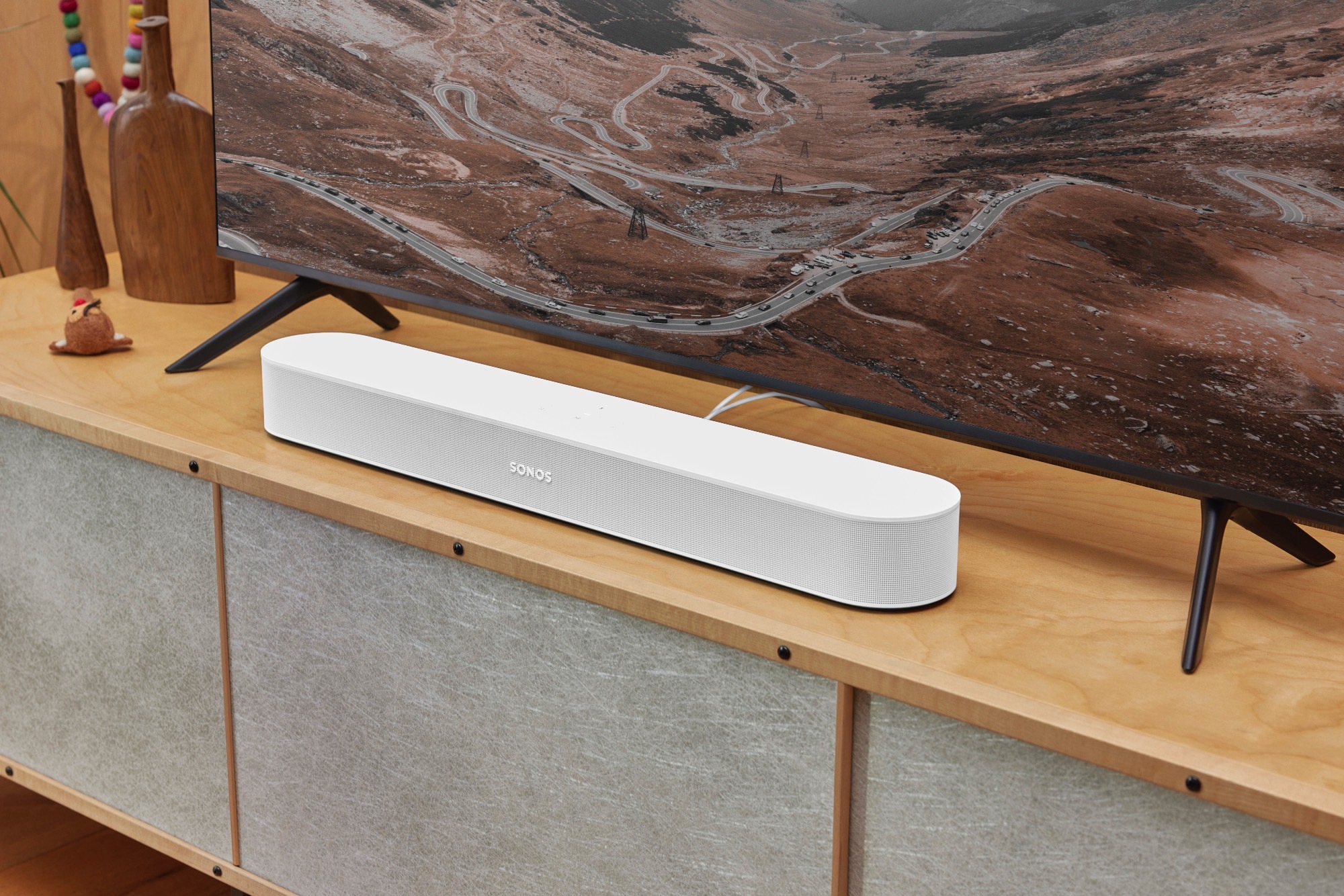Sonos has just announced its second-generation Beam soundbar for small to medium-sized TV rooms. The newest version looks almost identical to the original Beam, but under the hood, Sonos has given the Beam Gen 2 a more powerful processor and the ability to reproduce Dolby Atmos sound. Priced at $449 — $50 more than the first-gen Beam, which the second-gen replaces — you can pre-order the Beam Gen 2 in white or black today, with availability scheduled for October 5.
Acoustically speaking, the Beam Gen 2 uses the same components as its predecessor: Five drivers powered by five discrete Class-D amplifiers. But Sonos has improved the phased speaker array to better steer sound around a room and added the digital smarts it needs to create a virtual set of height and surround sound channels that use those drivers. The level of Dolby Atmos immersion may not be as intense as a soundbar like the Sonos Arc, with its dedicated upward-firing height drivers, but given that the Beam is aimed at smaller rooms, that might actually work in its favor.

The Beam Gen 2 retains the original soundbar’s dimensions and shape, and they look very similar at a distance, but Sonos has swapped out the original Beam’s cloth grille for a plastic grille that uses hundreds of tiny holes instead. This brings the new Beam more in line with the company’s other speakers like the Sonos Five, Arc, and One, all of which use hard plastic or metal grilles.
The new model also preserves the first-gen’s ports: You get a single HDMI ARC/eARC port and an Ethernet port. To use the Beam with a TV that doesn’t support HDMI ARC/eARC, Sonos also includes an optical-to-HDMI adapter. This was a good solution for the first Beam because it only supported stereo or Dolby Digital sources, both of which can be transmitted over an optical connection. But Dolby Atmos is a different beast — it requires Dolby Digital Plus, Dolby TrueHD, or Dolby MAT to work, and all three of these formats are not compatible with optical connections.
If your TV only supports optical connections, there’s no way for you to send Dolby Atmos content to the soundbar. However, it’s not a total deal-breaker. Sonos has added in some additional digital signal processing that lets the Beam Gen 2 “upscale” non-Dolby Atmos sound sources into a much more immersive experience, using the same technology that it leverages for the virtual height and surround channels. It won’t sound quite as good as genuine Atmos might, but it should still be considerably better than what the first-gen Beam could muster.
Like all Sonos speakers, you control the Beam Gen 2 via the Sonos app on a smartphone, tablet, or computer, but you can also control basic functions like volume, mute, and power from your TV’s remote control. These commands can be passed along from the TV over HDMI CEC if your TV supports it, or you can use the Beam’s built-in infrared receiver to send the commands directly.
You also get Apple AirPlay 2, and just like the original Beam, you can choose to set up Google Assistant or Amazon Alexa as the built-in smart speaker voice assistant. New on the second-gen version is the inclusion of near-field communication (NFC), which lets you set up the Beam even faster than before if your smartphone supports NFC-equipped devices.
You can expand the Beam into a full-fledged home theater system by adding a Sono Sub for better low-frequency bass, and you can also add several matched pairs of Sonos’ other wireless speakers to act as discrete surrounds.
Along with the new Beam, Sonos announced that it’s going to add support for Amazon Music’s Ultra High Definition audio, which offers tracks in lossless audio up to 24-bit/48kHz, as well as Dolby Atmos Music. Ultra High Definition will work on all S2-compatible products, except Play:1, Play:3, Playbase, and Playbar, while Dolby Atmos Music will work on Arc and Beam (Gen 2). Sonos also announced plans to add support for decoding DTS Digital Surround later this year via the S2 platform on Playbar, Playbase, Amp, and both generations of Beam and Arc.
When Digital Trends asked if similar support would be added for services like Tidal, Apple Music, and Qobuz, we were told that it would be up to each music service to decide if they wanted to take advantage of the new capabilities. We’ll take that as a “yes,” but clearly the rollouts for these services won’t be happening right away.






